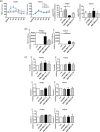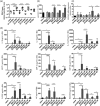Respiratory syncytial virus infection influences tight junction integrity
- PMID: 28856667
- PMCID: PMC5680068
- DOI: 10.1111/cei.13042
Respiratory syncytial virus infection influences tight junction integrity
Abstract
Respiratory syncytial virus (RSV) is an important risk factor of asthma development and is responsible for severe respiratory tract infections. However, the influence of RSV infection on barrier function of bronchial epithelial cells in vitro and in vivo is still unclear. The aim of this study was to analyse the role of RSV in tight junction (TJ) regulation and to compare epithelial integrity between asthmatic and healthy individuals upon RSV infection. Healthy and asthmatic human bronchial epithelial cells (HBECs) were differentiated at air-liquid interface (ALI) and infected with RSV and ultraviolet (UV)-irradiated RSV. TJ expression and their integrity were analysed by quantitative polymerase chain reaction (qPCR), transepithelial resistance (TER) and paracellular flux. To determine the effect in vivo, BALB/c mice were infected intranasally with RSV or UV-irradiated RSV A2. Bronchoalveolar lavage and TJ integrity were analysed on days 1, 2, 4 and 6 post-infection by qPCR, bioplex and confocal microscopy. RSV increased barrier integrity in ALI cultures of HBEC from healthy subjects, but no effect was found in HBECs from asthmatics. This was not associated with an increase in TJ mRNA expression. In vivo, RSV induced lung inflammation in mice and down-regulated claudin-1 and occludin mRNA expression in whole lungs. Surprisingly, RSV infection was not observed in bronchial epithelial cells, but was found in the lung parenchyma. Decreased expression of occludin upon RSV infection was visible in mouse bronchial epithelial cells in confocal microscopy. However, there was no regulation of claudin-1 and claudin-7 at protein level.
Keywords: airway epithelial cells; asthma; respiratory syncytial virus; tight junctions.
© 2017 British Society for Immunology.
Figures




Similar articles
-
Effects of human rhinovirus on epithelial barrier integrity and function in children with asthma.Clin Exp Allergy. 2018 May;48(5):513-524. doi: 10.1111/cea.13097. Epub 2018 Feb 20. Clin Exp Allergy. 2018. PMID: 29350877
-
Disruption of the airway epithelial barrier in a murine model of respiratory syncytial virus infection.Am J Physiol Lung Cell Mol Physiol. 2019 Feb 1;316(2):L358-L368. doi: 10.1152/ajplung.00345.2018. Epub 2018 Nov 29. Am J Physiol Lung Cell Mol Physiol. 2019. PMID: 30489157 Free PMC article.
-
A nuclear factor-κB signaling pathway via protein kinase C δ regulates replication of respiratory syncytial virus in polarized normal human nasal epithelial cells.Mol Biol Cell. 2011 Jul 1;22(13):2144-56. doi: 10.1091/mbc.E10-11-0875. Epub 2011 May 11. Mol Biol Cell. 2011. PMID: 21562222 Free PMC article.
-
Respiratory syncytial virus infection and the tight junctions of nasal epithelial cells.Adv Otorhinolaryngol. 2011;72:153-6. doi: 10.1159/000324777. Epub 2011 Aug 18. Adv Otorhinolaryngol. 2011. PMID: 21865717 Review.
-
Interferon response and respiratory virus control are preserved in bronchial epithelial cells in asthma.J Allergy Clin Immunol. 2014 Dec;134(6):1402-1412.e7. doi: 10.1016/j.jaci.2014.07.013. Epub 2014 Sep 9. J Allergy Clin Immunol. 2014. PMID: 25216987 Free PMC article.
Cited by
-
Serum Calcium and Vitamin D levels: Correlation with severity of COVID-19 in hospitalized patients in Royal Hospital, Oman.Int J Infect Dis. 2021 Jun;107:153-163. doi: 10.1016/j.ijid.2021.04.050. Epub 2021 Apr 20. Int J Infect Dis. 2021. PMID: 33892191 Free PMC article.
-
Leukocyte redistribution as immunological biomarker of corticosteroid resistance in severe asthma.Clin Exp Allergy. 2022 Oct;52(10):1183-1194. doi: 10.1111/cea.14128. Epub 2022 Apr 1. Clin Exp Allergy. 2022. PMID: 35305052 Free PMC article.
-
Role of vitamin D in COVID-19 and other viral infections.World J Virol. 2024 Sep 25;13(3):95349. doi: 10.5501/wjv.v13.i3.95349. World J Virol. 2024. PMID: 39323448 Free PMC article. Review.
-
Type 2 chronic inflammatory diseases: targets, therapies and unmet needs.Nat Rev Drug Discov. 2023 Sep;22(9):743-767. doi: 10.1038/s41573-023-00750-1. Epub 2023 Aug 1. Nat Rev Drug Discov. 2023. PMID: 37528191 Review.
-
Evaluation of Intestinal Permeability in Children Diagnosed With Bronchiolitis in Pediatric Emergency Department: A Cross-Sectional Study.Pediatr Pulmonol. 2025 Jun;60(6):e71171. doi: 10.1002/ppul.71171. Pediatr Pulmonol. 2025. PMID: 40536172 Free PMC article.
References
-
- Johnson JE, Gonzales RA, Olson SJ, Wright PF, Graham BS. The histopathology of fatal untreated human respiratory syncytial virus infection. Mod Pathol 2007; 20:108–19. - PubMed
Publication types
MeSH terms
Substances
Grants and funding
LinkOut - more resources
Full Text Sources
Other Literature Sources
Medical

